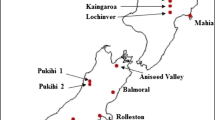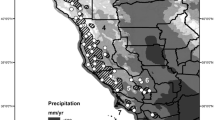Abstract
A successful clonal forestry program for loblolly pine based on rooted cutting technology needs to consider selection for both rooting ability and subsequent field growth. Rooting ability and second-year height were assessed in more than 2,000 clones from 70 full-sib families of loblolly pine. The bivariate analysis of rooting ability from five rooting trials and field growth from six field trials allowed for estimation of the genetic covariance between rooting ability and second-year height for parental effects, full-sib family effects, and the total genetic value of clones within full-sib family. There was a positive genetic relationship between rooting ability and second-year height at all three genetic levels. The genetic correlation at the parental level between rooting ability and second-year height \({\left( {\widehat{r}_{{{\text{B}}_{{{\text{GCA}}}} }} } \right)}\) was 0.32. At the full-sib family level, the genetic correlation between traits \({\left( {\widehat{r}_{{{\text{B}}_{{{\text{FS}}}} }} } \right)}\) was 0.39. The correlation of total genetic values of clones for rooting ability and second-year height \({\left( {\widehat{r}_{{{\text{B}}_{{{\text{TG}}}} }} } \right)}\) was 0.29. The genetic gain in rooting ability and second-year height was estimated for a number of deployment options based on various selection scenarios using the best linear unbiased prediction (BLUP) values from the bivariate analysis. The deployment strategies compared were (1) half-sib family deployment, (2) full-sib family deployment, and (3) clonal deployment. Moderate to high family and clonal mean heritabilities, moderate to high type B genetic correlations, and substantial among-family and among-clone genetic variation indicate the potential for increasing rooting efficiency and improving growth.



Similar content being viewed by others
References
Balocchi CE, Bridgewater FE, Zobel BJ, Jahromi S (1993) Age trends in genetic parameters for tree height in a nonselected population of loblolly pine. For Sci 39(2):231–251
Baltunis BS (2005) Genetic effects of rooting ability and early growth traits in loblolly pine clones. Ph.D. Dissertation, University of Florida, Gainesville, FL, p 101
Baltunis BS, Huber DA, White TL, Goldfarb B, Stelzer HE (2005) Genetic effects of rooting loblolly pine stem cuttings from a partial diallel mating design. Can J For Res 35:1098–1108
Baltunis BS, Huber DA, White TL, Goldfarb B, Stelzer HE (2006) Genetic analyses of early field growth of loblolly pine clones and seedlings from the same full-sib families. Can J For Res (in press)
Banks BD, Mao IL, Walter JP (1985) Robustness of the restricted maximum likelihood estimator derived under normality as applied to data with skewed distributions. J Dairy Sci 68:1785–1792
Bridgewater FE, Bramlett DL, Byram TD, Lowe WJ (1998) Controlled mass pollination in loblolly pine to increase genetic gains. For Chron 74:1–5
Burdon RD, Aimers-Halliday J (2003) Risk management for clonal forestry with Pinus radiata-analysis and review. 1: strategic issues and risk spread. N Z J For Sci 33(2):156–180
Cotterill PP, Dean CA (1990) Successful tree breeding with index selection. Center for Scientific and Industrial Research Organization (CSIRO), Collingwood, Victoria, Australia, p 80
Dieters MJ (1994) Inheritance of volume and rust resistance in slash pine. Ph.D. Dissertation, University of Florida, Gainesville, FL, p 105
Falconer DS, Mackay TFC (1996) Introduction to quantitative genetics, 4th edn. Longman, Essex, England, p 464
Forest Biology Research Cooperative (FBRC) (2000) Study B: clonal biology and performance of elite genotypes of loblolly and slash pine. FBRC Report # 13. Forest Biology Research Cooperative, Univ. Florida, Gainesville, FL, p 31
Foster GS (1990) Genetic control of rooting ability of stem cuttings from loblolly pine. Can J For Res 20:1361–1368
Foster GS, Shaw DV (1988) Using clonal replicates to explore genetic variation in a perennial plant species. Theor Appl Genet 76:788–794
Foster GS, Campbell RK, Adams WT (1984) Heritability, gain, and C effects in rooting of western hemlock cuttings. Can J For Res 14:628–638
Foster GS, Campbell RK, Adams WT (1985) Clonal selection prospects in western hemlock combining rooting traits with juvenile height growth. Can J For Res 15:488–493
Foster GS, Stelzer HE, McRae JB (2000) Loblolly pine cutting morphological traits: effects on rooting and field performance. New For 19:291–306
Gilmour AR, Gogel BJ, Cullis BR, Welham SJ, Thompson R (2002) ASReml User Guide Release 1.0. VSN International, Hemel Hempstead, HP1 1ES, UK, p 267
Goldfarb B, Surles SE, Thetford M, Blazich FA (1998) Effects of root morphology on nursery and first-year field growth of rooted cuttings of loblolly pine. South J Appl For 22(4):231–234
Huber DA, White TL, Hodge GR (1992) The efficiency of half-sib, half-diallel and circular mating designs in the estimation of genetic parameters in forestry: a simulation. For Sci 38(4):757–776
Huber DA, White TL, Hodge GR (1994) Variance component estimation techniques compared for two mating designs with forest genetic architecture through computer simulation. Theor Appl Genet 88:236–242
Isik F, Goldfarb B, LeBude A, Li B, McKeand S (2005) Predicted genetic gains and testing efficiency from two loblolly pine clonal trials. Can J For Res 35:1754–1766
Jacobs DF, Salifu KF, Seifert JR (2005) Relative contribution of initial root and shoot morphology in predicting field performance of hardwood seedlings. New For 30:235–251
Jannson G, Li B (2004) Genetic gains of full-sib families from disconnected diallels in loblolly pine. Silvae Genet 53:60–64
Jayawickrama KJS (2001) Estimated among-family and within-family variances and heritabilities from three radiata pine clonal trials. For Genet 8(3):247–257
Kendall MG, Stuart A (1963) The advanced theory of statistics, vol 1. Hafner, New York, p 433
King JN, Johnson GR (1991) Genetic parameter estimates from a young clonal test. FRI Bulletin 160, NZFRI, Rotorua, New Zealand, pp 98–100
Libby WJ, Jund E (1962) Variance associated with cloning. Heredity 17:533–540
McKeand S, Mullin T, Byram T, White T (2003) Deployment of genetically improved loblolly and slash pines in the south. J For 101:32–37
Mullin TJ, Morgenstern EK, Park YS, Fowler DP (1992) Genetic parameters from a clonally replicated test of black spruce (Picea mariana). Can J For Res 22:24–36
Namkoong G (1979) Introduction to quantitative genetics in forestry. USDA For Serv Tech Bull No 1588, p 342
Paul AD, Foster GS, Lester DT (1993) Field performance, C effects, and their relationship to initial rooting ability for western hemlock clones. Can J For Res 23:1947–1952
Paul AD, Foster GS, Caldwell T, McRae J (1997) Trends in genetic and environmental parameters for height, diameter, and volume in a multilocation clonal study with loblolly pine. For Sci 43:87–98
Radosta P, Paques LE, Verger M (1994) Estimation of genetic and nongenetic parameters for rooting traits in hybrid larch. Silvae Genet 43:108–114
Rowe DB, Blazich FA, Goldfarb B, Wise FC (2002) Nitrogen nutrition of hedged stock plants of loblolly pine. II. Influence of carbohydrate and nitrogen status on adventitious rooting of stem cuttings. New For 24:53–65
Schwaegerle KE (2005) Quantitative genetic analysis of plant growth: biases arising from vegetative propagation. Evolution 59:1259–1267
Shepherd M, Mellick R, Toon P, Dale G, Dieters M (2005) Genetic control of adventitious rooting on stem cuttings in two Pinus elliottii x P. caribaea hybrid families. Ann For Sci 62:403–412
Stonecypher RW, McCullough RB (1986) Estimates of additive and non-additive genetic variances from a clonal diallel of Douglas-fir Pseudotsuga mensiesii (Mirb.) Franco. In: Proceedings of the IUFRO Joint Meeting of the Working Parties for Breeding Theory, Progeny Testing, and Seed Orchards, 13–17 Oct. 1986, Williamsburg, VA. North Carolina State University-Industry Cooperative Tree Improvement Program, Raleigh, NC, pp 211–227
Stonecypher RW, Piesch RF, Helland GG, Chapman JG, Reno HJ (1996) Results from genetic tests of selected parents of Douglas-fir (Pseudotsuga menziesii (Mirb.) Franco) in an applied tree improvement program. For Sci Monogragh 32, p 35
Weber J, Stelzer H (2002) Operational rooted cuttings in southern pines. In: National Proceedings: Forest and Conservation Nursery Associations—1999, 2000, and 2001. Technical coordinators R.K. Dumroese, L.E. Riley, and T.D. Landis. Proceedings RMRS-P-24. USDA Forest Service, Rocky Mountain Research Station, Ogden, Utah, pp 91–92
Westfall PH (1987) A comparison of variance component estimates for arbitrary underlying distributions. J Amer Stat Assoc 82(399):866–874
Williams ER, Matheson AC, Harwood CE (2002) Experimental design and analysis for tree improvement, 2nd edn. CSIRO, Collingwood, Victoria, Australia, p 214
Wise FC, Caldwell TD (1994) Macropropagation of conifers by stem cuttings. In: Foster GS, Diner AM (eds) Applications of vegetative propagation in forestry. USDA Forest Service, Southern Forest Experiment Station, New Orleans. Gen Tech Rep SO-108, pp 51–73
Wu HX, Matheson AC (2005) Genotype by environment interactions in an Australia-wide radiata pine diallel mating experiment: implications for regionalized breeding. For Sci 51(1):29–40
Xiang B, Li B, McKeand S (2003) Genetic gain and selection efficiency of loblolly pine in three geographic regions. For Sci 49(2):196–208
Acknowledgements
The authors thank the members of the Forest Biology Research Cooperative for supporting this research. The authors extend their appreciation to the FBRC members who installed a study site: Weyerhaeuser, Plum Creek, Rayonier, MeadWestvaco, and International Paper Company. Special thanks go to the University of Georgia for also establishing a study site. We thank Dr. Harry Wu for helpful comments on an earlier draft. Also, appreciation is extended to the two anonymous reviewers and Randy Johnson (Associate Editor) for their many relevant suggestions. This research was supported by the Florida Agricultural Experiment Station, and approved for publication as Journal Series No. R-XXXX.
Author information
Authors and Affiliations
Corresponding author
Additional information
Communicated by R. Johnson
Rights and permissions
About this article
Cite this article
Baltunis, B.S., Huber, D.A., White, T.L. et al. Genetic gain from selection for rooting ability and early growth in vegetatively propagated clones of loblolly pine. Tree Genetics & Genomes 3, 227–238 (2007). https://doi.org/10.1007/s11295-006-0058-9
Received:
Revised:
Accepted:
Published:
Issue Date:
DOI: https://doi.org/10.1007/s11295-006-0058-9




